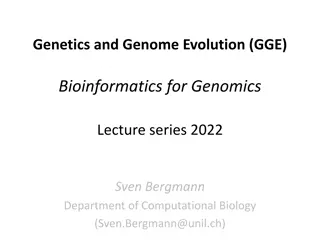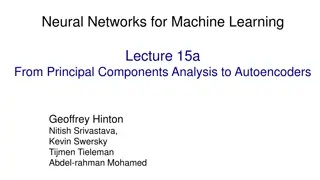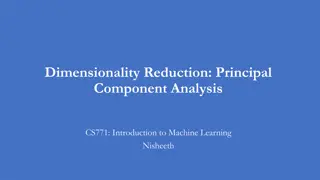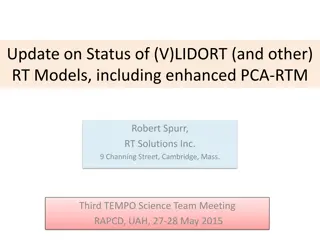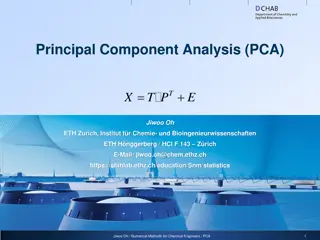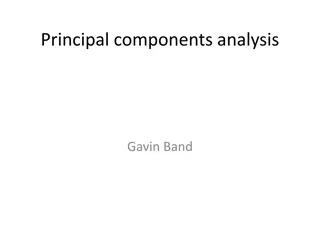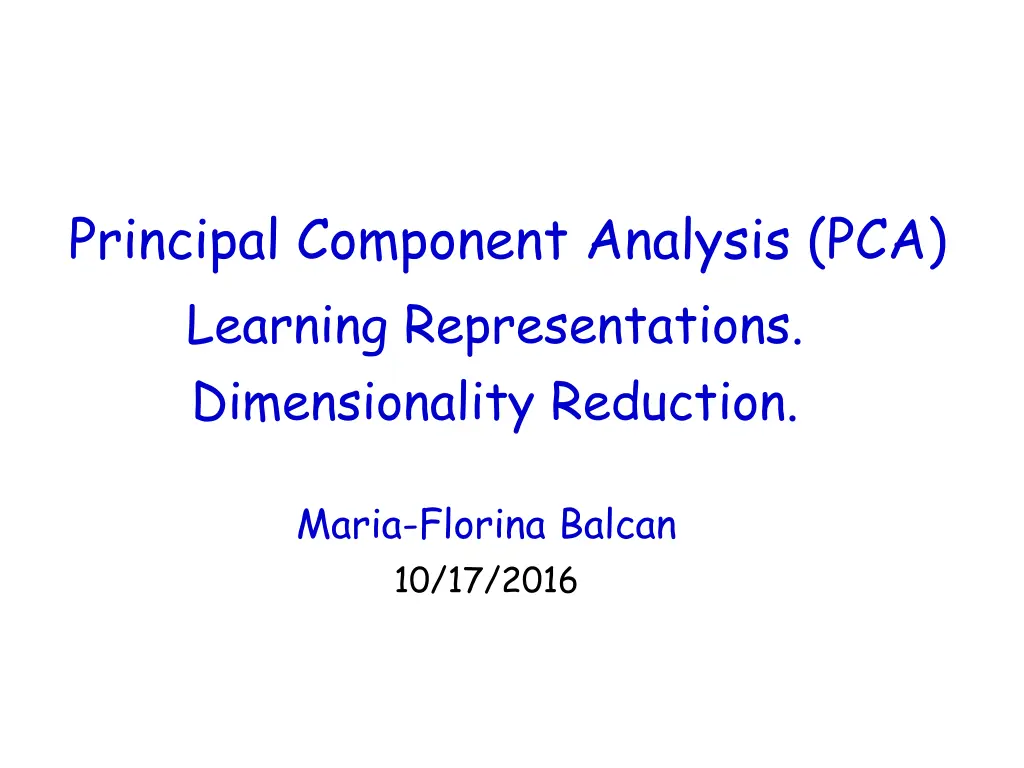
Understanding Principal Component Analysis (PCA) for High-Dimensional Data
Explore the power of Principal Component Analysis (PCA) and its role in learning representations for high-dimensional data sets. Discover how PCA, along with other techniques like Kernel PCA and ICA, can extract hidden structures efficiently, leading to better visualization, resource optimization, and improved data quality. Uncover the essence of PCA as an unsupervised method for variance structure extraction, enabling dimensionality reduction while maximizing data variance.
Download Presentation

Please find below an Image/Link to download the presentation.
The content on the website is provided AS IS for your information and personal use only. It may not be sold, licensed, or shared on other websites without obtaining consent from the author. If you encounter any issues during the download, it is possible that the publisher has removed the file from their server.
You are allowed to download the files provided on this website for personal or commercial use, subject to the condition that they are used lawfully. All files are the property of their respective owners.
The content on the website is provided AS IS for your information and personal use only. It may not be sold, licensed, or shared on other websites without obtaining consent from the author.
E N D
Presentation Transcript
Principal Component Analysis (PCA) Learning Representations. Dimensionality Reduction. Maria-Florina Balcan 10/17/2016
Big & High-Dimensional Data High-Dimensions = Lot of Features Document classification Features per document = thousands of words/unigrams millions of bigrams, contextual information Surveys - Netflix 480189 users x 17770 movies
Big & High-Dimensional Data High-Dimensions = Lot of Features MEG Brain Imaging 120 locations x 500 time points x 20 objects Or any high-dimensional image data
Big & High-Dimensional Data. Useful to learn lower dimensional representations of the data.
Learning Representations PCA, Kernel PCA, ICA: Powerful unsupervised learning techniques for extracting hidden (potentially lower dimensional) structure from high dimensional datasets. Useful for: Visualization More efficient use of resources (e.g., time, memory, communication) Statistical: fewer dimensions better generalization Noise removal (improving data quality) Further processing by machine learning algorithms
Principal Component Analysis (PCA) What is PCA: Unsupervised technique for extracting variance structure from high dimensional datasets. PCA is an orthogonal projection or transformation of the data into a (possibly lower dimensional) subspace so that the variance of the projected data is maximized.
Principal Component Analysis (PCA) If we rotate data, again only one coordinate is more important. Intrinsically lower dimensional than the dimension of the ambient space. Only one relevant feature Both features are relevant Question: Can we transform the features so that we only need to preserve one latent feature?
Principal Component Analysis (PCA) In case where data lies on or near a low d-dimensional linear subspace, axes of this subspace are an effective representation of the data. Identifying the axes is known as Principal Components Analysis, and can be obtained by using classic matrix computation tools (Eigen or Singular Value Decomposition).
Principal Component Analysis (PCA) Principal Components (PC) are orthogonal directions that capture most of the variance in the data. First PC direction of greatest variability in data. Projection of data points along first PC discriminates data most along any one direction (pts are the most spread out when we project the data on that direction compared to any other directions). Quick reminder: xi v ||v||=1, Point xi (D-dimensional vector) Projection of xi onto v is v xi v xi
Principal Component Analysis (PCA) Principal Components (PC) are orthogonal directions that capture most of the variance in the data. 1st PC direction of greatest variability in data. xi xi v xi v xi 2nd PC Next orthogonal (uncorrelated) direction of greatest variability (remove all variability in first direction, then find next direction of greatest variability) And so on
Principal Component Analysis (PCA) Let v1, v2, , vd denote the d principal components. vi vj = 0,i j and vi vi = 1, i = j Assume data is centered (we extracted the sample mean). Let X = [x1,x2, ,xn] (columns are the datapoints) Find vector that maximizes sample variance of projected data Wrap constraints into the objective function
Principal Component Analysis (PCA) X XTv = v , so v (the first PC) is the eigenvector of sample correlation/covariance matrix ? ?? Sample variance of projection v?? ??v = ?v?v = ? Thus, the eigenvalue ? denotes the amount of variability captured along that dimension (aka amount of energy along that dimension). Eigenvalues ?1 ?2 ?3 The 1st PC ?1 is the the eigenvector of the sample covariance matrix ? ?? associated with the largest eigenvalue The 2nd PC ?2 is the the eigenvector of the sample covariance matrix ? ?? associated with the second largest eigenvalue And so on
Principal Component Analysis (PCA) So, the new axes are the eigenvectors of the matrix of sample correlations ? ?? of the data. Transformed features are uncorrelated. x2 x1 Geometrically: centering followed by rotation. Linear transformation Key computation: eigendecomposition of ??? (closely related to SVD of ?).
Two Interpretations So far: Maximum Variance Subspace. PCA finds vectors v such that projections on to the vectors capture maximum variance in the data Alternative viewpoint: Minimum Reconstruction Error. PCA finds vectors v such that projection on to the vectors yields minimum MSE reconstruction xi v v xi
Two Interpretations E.g., for the first component. Maximum Variance Direction: 1st PC a vector v such that projection on to this vector capture maximum variance in the data (out of all possible one dimensional projections) Minimum Reconstruction Error: 1st PC a vector v such that projection on to this vector yields minimum MSE reconstruction xi v v xi
Why? Pythagorean Theorem E.g., for the first component. Maximum Variance Direction: 1st PC a vector v such that projection on to this vector capture maximum variance in the data (out of all possible one dimensional projections) Minimum Reconstruction Error: 1st PC a vector v such that projection on to this vector yields minimum MSE reconstruction blue2 + green2 = black2 xi v black2is fixed (it s just the data) v xi So, maximizing blue2 is equivalent to minimizing green2
Dimensionality Reduction using PCA The eigenvalue ? denotes the amount of variability captured along that dimension (aka amount of energy along that dimension). Zero eigenvalues indicate no variability along those directions => data lies exactly on a linear subspace Only keep data projections onto principal components with non-zero eigenvalues, say v1, ,vk, where k=rank(? ??) Original representation Transformed representation Data point projection (?1 ??, ,?? ??) xi v 1, ,?? ?) ??= (?? vTxi D-dimensional vector d-dimensional vector
Dimensionality Reduction using PCA In high-dimensional problems, data sometimes lies near a linear subspace, as noise introduces small variability Only keep data projections onto principal components with large eigenvalues Can ignore the components of smaller significance. 25 20 Variance (%) 15 10 5 0 PC1 PC2 PC3 PC4 PC5 PC6 PC7 PC8 PC9 PC10 Might lose some info, but if eigenvalues are small, do not lose much
PCA provably useful before doing k-means clustering and also empirically useful. E.g.,
PCA Discussion Strengths Eigenvector method No tuning of the parameters No local optima Weaknesses Limited to second order statistics Limited to linear projections 21
What You Should Know Principal Component Analysis (PCA) What PCA is, what is useful for. Both the maximum variance subspace and the minimum reconstruction error viewpoint.



